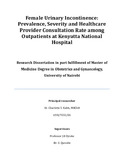| dc.description.abstract | Background: According to WHO, female urinary incontinence is a silent global epidemic and one of the last medical taboos. It is associated with high economic costs, psychological morbidity and adverse effects on the quality of life. The prevalence of urinary incontinence is reported to range between 25 % and 69 % among women aged 18 years or more and affects about a quarter billion women worldwide.
Despite this, it is associated with low physician consultation rates which have been attributed to shame, embarrassment, fear of surgery and a misconception that being incontinent is an inevitable consequence of age and/or child birth.
Main objectives: To establish the prevalence, severity and healthcare provider consultation rate of female urinary incontinence among outpatients at Kenyatta National Hospital.
Main outcome measures: Presence of urinary incontinence symptoms, severity of the urinary incontinence symptoms as determined by interpretation of the severity index and rate of healthcare provider consultation among those suffering from urinary incontinence. Design setting and population: A hospital based cross sectional survey carried out at Kenyatta National Hospital.
One hundred and fifty consenting women aged 18 years or more and attending the family welfare, medical and gynecology clinics were recruited using convenience sampling and a provider administered questionnaire used to collect data.
Results: The prevalence of female urinary incontinence at Kenyatta national hospital was found to be 64% of which 18.7%,39.6% and 41.7% had stress, urge and mixed incontinence respectively. There was a slight increase in odds of urinary incontinence with increase in age although this was not statistically significant in the adjusted logistic regression (OR 1.03 95% el1.00, 1.06) p value 0.814).
There was a statistically significant increase in oddsof UI with more than 10years duration since last delivery (OR 1.06 p value 0.007). Majority of the respondents had mild incontinence (53%) in terms of severity with 29% and 18% of them reporting symptoms of moderate and severe incontinence respectively. Only 11% ofthe respondents ever consulted healthcare personnel for their incontinence symptoms.
Conclusions and recommendations: Female urinary incontinence is quite prevalent in the local setting with most of the women experiencing mild incontinence. However, the healthcare consultation rate for patients with UI symptoms is very low. Healthcare providers should be enlightened on the high prevalence and encouraged to proactively diagnose and manage the condition. | en_US |

